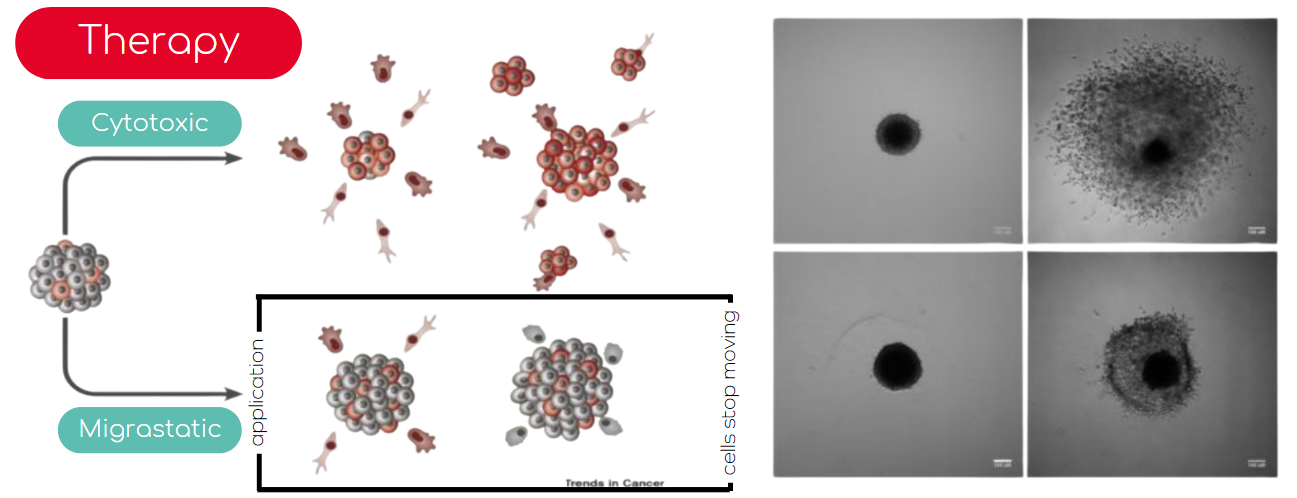What are migrastatics?
Metastasis, a defining feature of cancer, is a leading cause of cancer-related fatalities that lead to a patient’s death. Migrastatics, a new category of drugs, have been formulated to disrupt various cancer cell invasion mechanisms, consequently impeding cancer metastatic potential.
The migrastatics concept enables the development of a new drug class solely targeting the inhibition of cancer cell motility without cytotoxic or antiproliferative effects. With an open regulatory pathway and identified migrastatic candidates, we’re in for a new era in antimetastatic treatment. Recently, the first antimetastatic treatments have gained approval.

How do we know about migrastatics?
To our knowledge, the first person to coin the term migrastatics is doc. RNDr. Jan Brábek. He completed his master’s and doctoral studies at the Faculty of Science of Charles University in Prague. In his dissertation, he described the regulation mechanisms of Src family kinases. During his postdoctoral fellowship (2002-2004) at Vanderbilt University, USA, under the supervision of Steven Hanks, he studied the role of integrin signaling in the motility and invasiveness of tumor cells. His research group focuses on molecular and cellular mechanisms of cancer cell invasiveness. In 2006 he was awarded the League Against Cancer Award for significant publications in the field. Since 2019, he has been testing substances with migrastatic effects. He is a laureate of the Czech Brains – the Invention Award. Currently researching at BIOCEV where he leads the Molecular and Cellular Mechanisms of Invasiveness of Tumour Cells research group.
Are migrastatics being used in contemporary medicine?
According to the article Are We Ready for Migrastatics? in recent years, there’s been a shift towards focusing on treatments that can prevent cancer from spreading, known as antimetastatic approaches. Regulatory agencies, like the FDA, have adapted their guidelines to consider ‘metastasis-free survival’ (MFS) as a valid measure of treatment success in clinical trials. This change is driven by promising results in trials testing of a new treatments that aim to prevent metastasis in prostate cancer. It’s important because it directs research and investments toward fighting metastasis rather than just reducing the size of tumors. This shift highlights the need for faster development of antimetastatic therapies.
An example of a current migrastatic drug can be Rebastinib. It targets the protein receptor Tie2, which promotes the growth of blood vessels (angiogenesis). It’s used as an antiangiogenic treatment. Recently, it has also shown potential as a therapy to target cancer metastasis. Researchers have tested Rebastinib in preclinical trials using mouse models of breast and pancreatic cancers to reduce the spread of cancer cells into blood vessels and circulation.
„At the moment, applied cancer research and the pharmaceutical industry need new ideas. The success rate of anticancer drugs compared to other categories of drugs for other diseases is very low. The percentage of drugs that make it from the first clinical trial to practice is very small, and the subsequent efficacy of drugs is also very low,“ explaines Jan Brábek
What are the benefits of treatment for cancer using migrastatics?
The central benefit lie in its uncharted territory, as most of the current research focuses on the termination of metastatic tumors. The field of inhibiting their potential to spread is still undiscovered. No evidence suggests that both treatments couldn’t be used together. This would allow for a strategy where the tumor is located, contained, and destroyed.
Current research on migrastatics
We have gathered several articles that we believe are worth reading, especially the article from 2021 “Are we ready for migrastatics?” which gives a good overview and introduction to the topic.
- 2023 – The mechanosensitive TRPV2 calcium channel promotes human melanoma invasiveness and metastatic potential
- 2023 – Primary assessment of medicines for expected migrastatic potential with holographic incoherent quantitative phase imaging
- 2022 – Marine migrastatics
- 2021 – Are We Ready for Migrastatics?
- 2021 – A preclinical pipeline to evaluate migrastatics as therapeutic agents in metastatic melanoma
In case you think that your article about migrastatics should be listed here, feel free to reach out to us, via contact page.